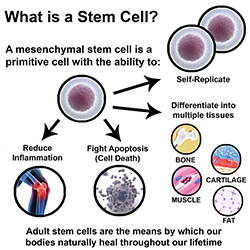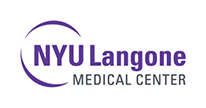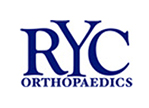Knee Stem Cell Therapy
What can i expect post-procedure?
Stem cell procedures are usually done as an outpatient,meaning there is no need for an overnight hospital stay. Most patients should expect to walk out of the clinic and resume low-impact activities immediately.
Some patients have reported experiencing mild pain for the first 48-72 hours post-procedure. In most cases, this is due to the absence of their normal anti-inflammatory and pain relief drugs. After this period, most patients experience a gradual decrease in pain, with some experiencing sustained pain relief. Soon afterward, patients may see improved function.

When can i resume physical activity?
The most important part of any stem cell therapy is adhering to your post-procedure restrictions. For the procedure to have the best chance to yield lasting benefits, most physicians strongly recommend:
- No anti-inflammatory medications for two weeks post-procedure.
- Rest as much as possible for the first 24-48 hours.
- Restrict the knee to general use for the first 2 weeks.
- For weeks 3-4, walking and cardio are allowed.
- After 4 weeks, weightlifting and running are permitted.
- Pay attention to your knee as you resume normal activity.
The ideal recipient of a stem cell procedure is a patient that wants to use their body’s own regenerative potential as an option to possibly delay or avoid invasive surgery.
The healthy knee
The knee joint is a complex, load-bearing hinge that relies on surrounding muscles, ligaments, and connective tissues for proper function. Here is a brief overview of the properties of a healthy knee.
- The human knee is composed of the end of the thigh bone (femur), the top of the shin (tibia),
and the kneecap (patella). - These bones are held together by tendons and ligaments, and separated by a shock-absorbing layer of smooth articular cartilage.
- The cartilage makes up both the lateral and medial meniscus, which allow the bones to glide
and roll over each other with little resistance.

Problems of the knee
Some common problems experienced in the knee include:
- Torn meniscal cartilage
- Damaged anterior cruciate ligament (ACL) or posterior cruciate ligament (PCL)
- Collateral ligament injuries
- Swollen or inflamed synovial membrane, the lining of the joint
- Small pieces of broken cartilage in the knee joint
- Articular cartilage defects
What is a stem cell procedure?
A stem cell procedure harnesses and amplifies the body’s natural mechanism for healing(and anti-inflammation). This mechanism uses adult autologous stem cells derived from your own bone marrow.
In the procedure, the physician will aspirate bone marrow from your hip, concentrate, then apply the concentrate to the injury site of the knee. In all, the process takes less than 45 minutes.
Depending on your condition, your doctor may decide to deliver the stem cells following an
arthroscopic procedure to remove damaged cartilage or bone. This will not affect the procedure; it allows the surgeon to visualize the target site.
Because your therapy will utilize a concentrated preparation of your own cells, the procedure is considered “autologous point-of-care”. The procedure is fast, and in most cases can be completed with moderate sedation.

Who is a good candidate for a stem cell procedure?
The ideal recipient of a stem cell procedure is a patient that wants to use their body’s own regenerative potential as an option to possibly delay or avoid invasive surgery.

Preparing for my procedure
As with any medical procedure, it is important to consult your physician about preparation.Because the stem cells communicate with the inflammatory environment around them, nonsteroidal anti-inflammatory drugs (NSAIDs) should not be taken for two weeks prior to the procedure
Preparing for my procedure
As with any medical procedure, it is important to consult your physician about preparation.
Because the stem cells communicate with the inflammatory environment around them, non-steroidal anti-inflammatory drugs (NSAIDs) should not be taken for two weeks prior to the procedure.






